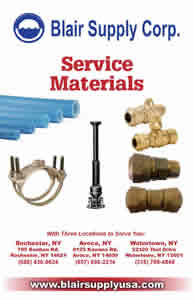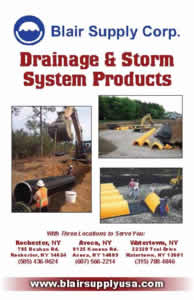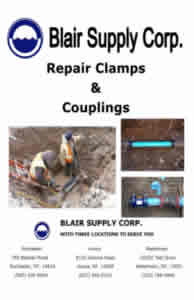Blog
About Municipal Water And Sewer Systems

A municipal water and sewer system is a complex network of pipes that delivers millions of gallons of fresh, potable water into homes and businesses, and removes excess water and sewage for treatment.
As we all know, water is a renewable resource that is provided through nature’s environmental cycle when it rains. While water is provided by nature, many of us rely on a complex network of pipes and pumps to actually get the water from nature into a municipal water systems to safely deliver clean water to our taps and then remove used water, or wastewater, from our homes and businesses.
How Does Water Get From The Source To Our Taps?
In municipal water systems, water is usually withdrawn from a freshwater river or lake and treated before it is pumped to a nearby municipality. The quality of the water is usually determined by the type of treatment method used before it is sent into the pipes; but it also depends on how old the pipes are as particles can mix with the water.
Most systems will include several stages of filtration to remove bacteria, dirt, debris, and other particles that can make us sick. After all the unwanted particles are removed, a disinfectant is added to the water which usually includes chlorine and then ultra violet light us used to further cleanse it.
After treatment, municipal water systems distribute water to homes and businesses in larger pipes called water mains that are usually buried under roadways. There are usually several thousand miles of pipes in a single municipality. Water mains are maintained by the local government and usually paid for with water rates and property taxes. The main lines are connected to smaller pipes that enter into buildings and then into taps where we are able to access it.
There some other parts of the water system that are often overlooked and those are the additional pipes, ditches and natural systems that channel rain water and snow away from buildings and back to the natural environment. These storm drains are to prevent flooding and water damage to buildings.
How Does The Sewer System Work?
After the water comes into our homes and businesses we then expel it through our sewer system. In most of the United States, residents depend on municipal sewer systems to take used water away from their homes and businesses. Occasionally, in more remote areas, residents collect their used water in private septic systems and a private company is responsible for removing it. After this used water is removed from a building through sewer pipes, it is pumped to a wastewater treatment facility where it is treated before it is released into a lake or river.
What Is Wastewater?
Wastewater is the term used for water originating from household, commercial, industrial, and agricultural facilities after it has been used.
Wastewater can be divided into water used in a household, like toilets, showers, taps and sinks and commercial and industrial wastewater, which comes from some type of economic production.
How Does The Municipal Wastewater Treatment Process Work?
First, wastewater is drained to the Wastewater Treatment Facility by gravity through the main sewer system.
Next, the first mechanical stage is called preliminary treatment where the water flows through a gravel chamber which removes the grit from water. Afterwards, gravel is disposed of at the dump. Water further reaches the bar screens used to remove large objects from the wastewater.
The next sedimentation stage is called primary treatment during which the wastewater flows to primary settling tanks. Water is then driven towards the hopper in the base of the tank. The hopper arm moves around the edge of the tank to remove any lingering particles. Treated water heads toward the edges and the particulates of higher sedimentation velocity than the flow velocity settle on the bottom of the tank.
This is the point where primary pre-treatment ends and secondary wastewater treatment starts. The secondary treatment uses a natural process to help filter the water. The treatment plant uses bacteria which consume the contaminants including all biodegradable material including carbon and phosphorus. The dead bacteria and organic residues then transform into a material called sludge.
During the biological stage, the excess sludge is pumped out and moved before the water enters the settling tanks. Here, the remaining sludge settles and is transported to digestion tanks for further treatment. Then the excess sludge is heated and mixed to give the wastewater a more even, liquid form. When the sludge digestion reaches the perfect level, the second digestion stage takes place in the storage tanks. Here, the water is separated from the sludge and transported back for further treatment, whereas the residual sludge undergoes mechanical treatment. The remaining sludge is then dried out as much as possible and disposed of at the dump where it is left to dry further. If the sludge complies with agricultural standards, it can be reused for fertilisation for plants and crops.
For the final step, wastewater is inspected by environmental workers. The aim of the inspector is to analyse the contamination level and ensure that the treated water complies with regulations and environmental laws.
How Cities Maintain Water And Sewer Systems
Most municipalities perform yearly sewer maintenance to avoid costly capital projects which extends the life of the piping system. However, even maintenance pipes deteriorate over time due to soil conditions and old age. The life expectancy of an underground sewer main is approximately a century.
What To Expect During A Municipal Water Project
Nobody likes to detour because of roadwork, but fixing pipes and sewage systems is unavoidable. Before upcoming construction starts on a water piping project, you will receive a letter in the mail from your local government outlining the project schedule, areas effected by construction and other details.
You can expect:
- Crews will dig a trench for the water or sewer main, to work on the piping system
- Parking restrictions will be in place to allow for digging and movement of supplies and equipment
- Periodic road closures, if necessary
- The crew usually starts at 8am and work and ends at 4pm but these times can shift depending on a variety of factors
Once the work is complete, the street and sidewalks will be repaved for car and pedestrian use. The work crews avoid repaving with grass sod or seed during hotter weather.
How to Start A Municipal Water Project
If you are interested in municipal water or wastewater treatment, contact us at Blair Supply Corporation. We have been in business since 1958 and are considered one of the top distributors in the water and wastewater industry, participating in over 25 local municipal organizations. The company has been in the family for three generations.






